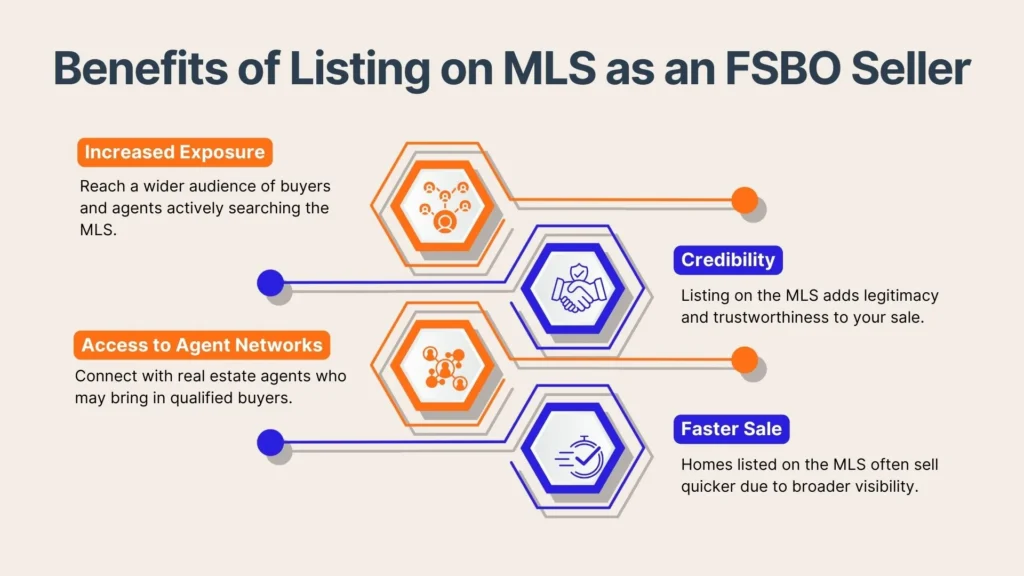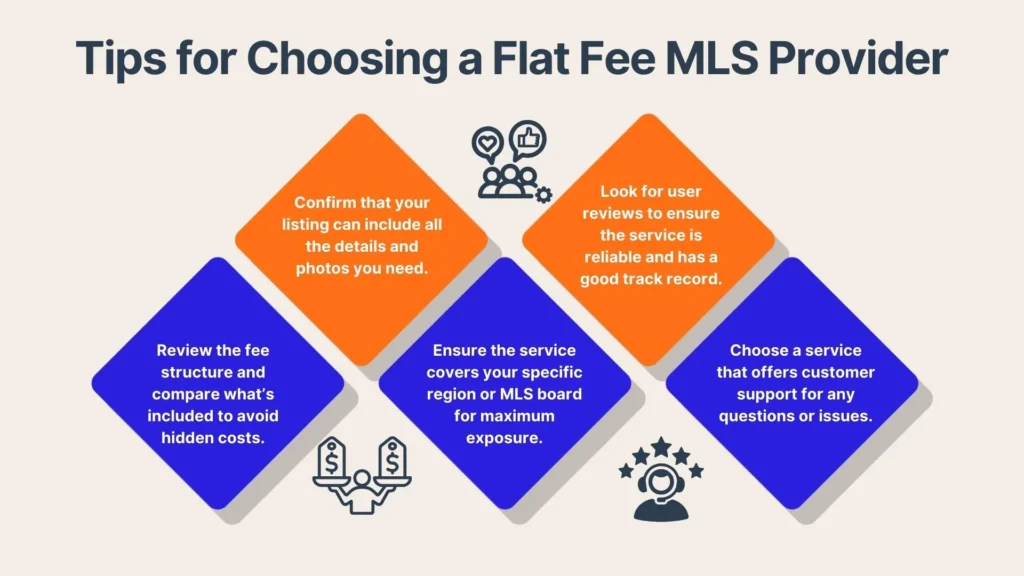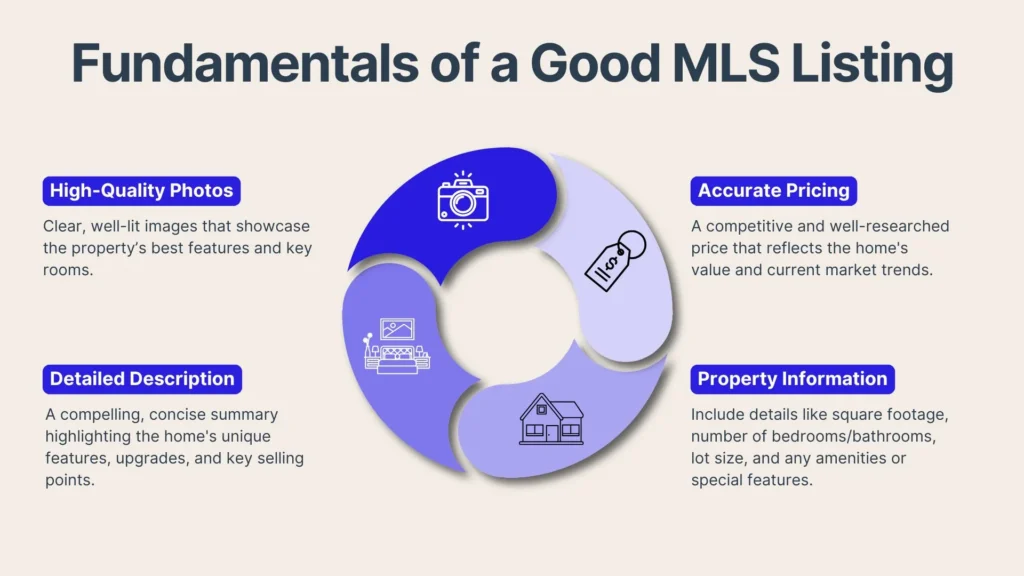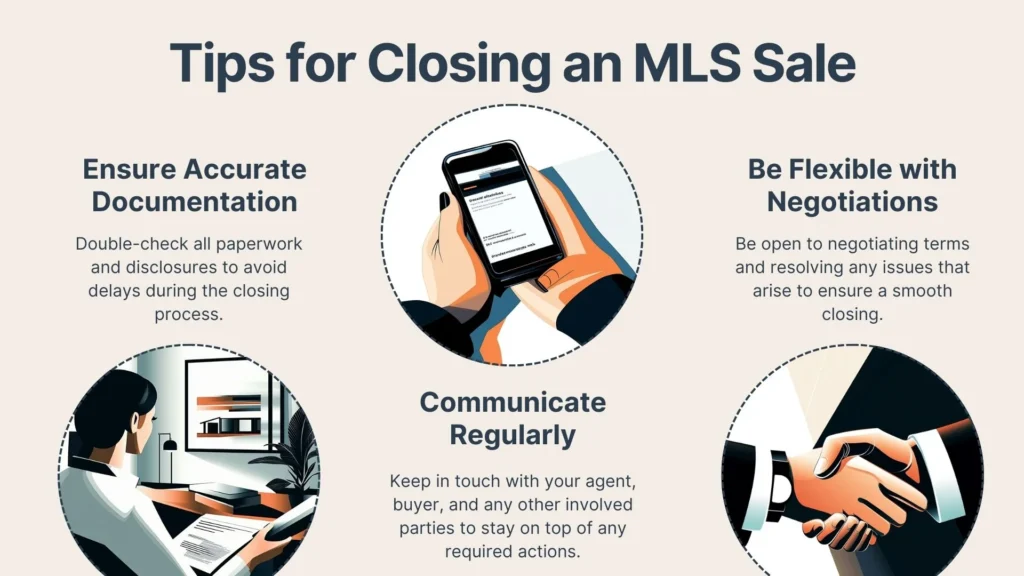Selling your home “For Sale by Owner” (FSBO) doesn’t mean giving up on one of the most powerful tools in real estate: the Multiple Listing Service (MLS). Placing your home on the MLS can vastly increase its visibility among buyers and their agents, all while letting you avoid paying a hefty commission.
In this guide, we’ll explore what the MLS is, why it matters for FSBO sellers, and how to properly prepare your listing. We’ll also look at choosing a flat fee MLS service, creating a standout property description, managing showings, and navigating closing procedures.
Ready to dive in? Let’s begin with the basics and understand exactly what MLS is and how it can help you sell your home.
What is MLS?
The MLS is a massive, agent-managed database of homes for sale. Each regional MLS ensures listings stay current and relevant, and once you’re on it, buyer agents can easily match your home with their clients.
Sites like Zillow and Realtor.com pull data straight from the MLS, so FSBO sellers often pay a flat fee for that extra exposure even if they’re not working with a full-service agent.
Why List on MLS as an FSBO Seller?
Selling on your own means handling everything, but listing on the MLS can attract serious buyers without sacrificing control. Agents use the MLS to find homes for their clients, putting your property in front of ready-to-buy prospects.
About 10% of FSBO sellers use it for marketing because it adds credibility and eases buyer concerns. In the end, the MLS can help you sell faster and possibly for a better price without extra hassle.

Preparing Your Home for Listing
Before listing your property on the MLS, take some time to make it shine. Start with a deep clean – think carpets, baseboards, and scuff marks.
Declutter each room so buyers focus on the home, not your stuff. Staging helps too; rearrange furniture to highlight key features and add simple decor for a cozy vibe. Don’t forget minor fixes like leaky faucets or chipped paint, because even small details matter. Well-maintained homes with great photos stand out from the competition.
Choosing a Flat Fee MLS Service
Now that your home is looking its best, the next move is to select a service that can officially post your property on the MLS. Flat fee MLS companies allow FSBO sellers to purchase a listing plan for a set price, eliminating the necessity for a traditional agent’s full commission.
But how do you figure out which flat fee plan to pick? Let’s explore the various packages, the extra services available, and some tips for comparing providers and their credentials.

Understanding Flat Fee MLS Packages
Flat fee MLS services offer packages from basic to full-featured. The basic plan gets your home listed for a set time, but you'll handle showings and offers yourself. Some states require broker involvement, so check the service's process. While some plans offer legal forms and guidance, others leave everything up to you.
Basic vs. Premium Packages
Basic flat-fee packages usually include an MLS listing, a set number of photos, and update options. Premium plans offer extras like pro photography, market analysis, and broker consultations. If you're confident in managing things yourself, a budget-friendly package works. But if you need more support with pricing or marketing, upgrading could be worth it.
Additional Services Offered
Beyond the standard MLS entry, many flat fee services have add-ons that make the selling process smoother. This could be social media advertising, a personalized property website, or even 3D virtual tours. Some also allow you to purchase yard signs or lockboxes at discounted rates, letting you hold showings more securely.
Although these extras can drive up the overall expense, they often provide extra marketing power. That said, be sure to weigh the cost of each add-on against the benefit it brings to your listing.
Comparing Flat Fee MLS Providers
Picking the right provider depends on local know-how, responsiveness, and service quality. Some cover the whole country, while others specialize in certain areas. If your market has unique trends, a local expert might be your best bet. Also, check how fast they post listings and reply to inquiries – delays could mean missed opportunities.
Reading Reviews and Testimonials
To gauge the reputation of a flat fee MLS provider, read what previous customers have to say. Look for comments about overall satisfaction, ease of communication, and whether the company delivered on its promises.
Bear in mind that overly glowing reviews on a site owned by the provider might not paint the entire picture. Instead, cross-reference reviews from independent platforms like Google or the Better Business Bureau to ensure you’re getting honest feedback.
Evaluating Provider Credentials
Check if the MLS provider you’re eyeing has any accreditations or is affiliated with recognized industry associations. Some companies might have awards or have been endorsed by trusted consumer programs.
Verifying credentials can give you peace of mind that you’re working with reputable professionals, especially if you’re unfamiliar with how the MLS process unfolds.
Picking the right flat fee MLS service is just the beginning. The real power lies in how your listing is shared. Try PropBox’s MLS and Online Portal Integration, it will make your property get maximum exposure by automatically appearing on multiple MLS sites and real estate platforms.
Creating Your MLS Listing
Once you’ve selected a flat fee MLS package, it’s time to craft a compelling listing. This step combines creativity with practical details so potential buyers can easily grasp the value of your home.
From drafting a memorable property description to outlining the square footage, here’s how to build a listing that truly stands out.

Writing a Compelling Property Description
Start with a quick, engaging summary that highlights your home’s best features, like a renovated kitchen or scenic backyard. Mention key details like bedrooms, bathrooms, and recent upgrades to attract the right buyers. A smooth, narrative style works best – save bullet points for a separate features list if allowed.
Emphasizing Unique Features
Buyers often look for special touches, so take a moment to think about what sets your home apart. Do you have custom cabinets or an energy-efficient HVAC system? Perhaps the backyard has a fire pit or a well-maintained garden that blossoms in the spring. Whatever it is, sprinkle these details throughout your description to emphasize your home’s distinct qualities.
Using Descriptive Language
Listings with engaging descriptions tend to perform better, with studies showing that homes featuring well-crafted language can sell up to 5% faster than those with generic descriptions.
Words like “cozy,” “sun-filled,” or “elegant” can evoke an emotional response. Try to paint a picture that helps buyers imagine themselves living there. For example, saying “Enjoy a peaceful morning coffee in the sunroom that overlooks a lush, tree-lined yard” creates a more vivid mental image than simply saying “Sunroom with a yard view.”
Categorizing Room Types and Amenities
Many MLS fields allow you to categorize room types (bedroom, dining area, study, etc.) and list amenities (granite countertops, hardwood floors, stainless steel appliances). Filling out these details thoroughly ensures that agents can filter for your home when their clients search for specific features, which expands your pool of interested buyers.
Including Square Footage and Lot Size
Accurate measurements are a must. Potential buyers often set their search parameters based on square footage or lot size. Verify these measurements before listing, especially if any additions or renovations have altered the property’s dimensions. Precise figures can help you sidestep confusion and avoid possible issues later in the selling process.
Managing Your Listing
After your MLS listing goes live, you’ll need to stay organized so you can swiftly respond to buyer inquiries and schedule showings.
Below are some practical steps for handling showings, negotiating offers, and putting together counteroffers that work to your advantage.
Scheduling Showings and Open Houses
Many FSBO sellers use online scheduling tools, such as Calendly or ShowingTime, to streamline appointment bookings. These tools allow prospective buyers and their agents to pick a time slot that suits them, making it more likely they’ll follow through.
Setting a few specific visiting hours each week can help you plan around work or family commitments. But if you’re working with limited hours and want to fast-track your sale, open houses are an efficient way to draw multiple buyers at once.
If you opt for an open house, invest in clear signage around your neighborhood and gather contact information from visitors. That way, you can follow up if someone shows strong interest.
Negotiating Offers
Once offers begin rolling in, you’ll need to analyze each one’s overall value. Look beyond just the price – closing timelines, financing terms, and contingencies also matter. A slightly lower offer with fewer contingencies may be a better bet than a higher one that could collapse due to financing pitfalls.
When you’re negotiating, remember you hold a powerful position: you can always say no. Approach discussions in a friendly, constructive tone, aiming to find a middle ground that satisfies both sides. Prompt responses can keep buyers engaged and excited about your property.
Counteroffer Strategies
If the initial offer isn’t quite up to your expectations, a well-thought-out counteroffer might save the deal. Identify what you’re willing to concede, whether it’s covering a certain closing cost or agreeing to a shorter closing period. In exchange, request something you value like a higher purchase price or waived inspection contingency. This give-and-take approach can help you find a balance that works for everyone.
Managing showings, offers, and counteroffers can be tough, but you can make it easier with a platform like PropBox. From AI-powered listing descriptions to top local photographer recommendations, your property will get the spotlight it deserves.
With MLS integration, virtual staging, and smart scheduling, handling your listing using Propbox is a breeze. Plus, AI-driven insights and automated counteroffers keep you ahead in negotiations.
Closing the Sale
Once you and a buyer agree on terms, the process moves into the closing phase. This is where everything from final inspections to escrow accounts comes into play.
To keep things running smoothly, make sure you understand your closing costs, itemize possible fees, and gather all the necessary documents ahead of time.
Understanding Closing Costs and Procedures
Closing costs usually cover lender fees, title insurance, escrow fees, and prorated property taxes. Who pays what depends on local customs or your contract.
Don’t forget to settle any remaining mortgage balance before the sale is final. In many states, a title company or attorney handles the paperwork, collects signatures, and ensures funds are transferred smoothly.

Itemizing Potential Fees
Potential fees could pop up that weren’t part of the initial negotiations. For example, some mortgage lenders require a home warranty or charge additional administrative fees. While you’re reviewing the closing disclosures, pay attention to any items you don’t recognize.
If something looks off, ask the lender or title company for an explanation or request a removal if it’s not mandatory.
Preparing Necessary Documents
To wrap up the sale without hiccups, assemble any paperwork that proves you have full authority to sell. This might include your deed, mortgage payoff information, homeowner association documents, and any inspection or repair records you’ve collected. Having these ready in advance can save you (and the buyer) a lot of last-minute stress.
Conclusion
Listing on the MLS as an FSBO seller is a powerful way to showcase your home while still maintaining control over the transaction. By preparing your property thoroughly, choosing the right flat fee MLS provider, creating a memorable listing, and staying organized throughout showings and negotiations, you can increase your chances of securing a successful sale. However, juggling all these tasks can feel overwhelming.
That’s where PropBox steps in – making the entire process a breeze with AI-powered tools that handle everything from writing killer listings to automating showings and negotiations. Don’t get buried in the details. Try PropBox today and enjoy a faster, easier, and more profitable sale.
